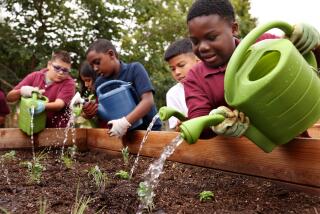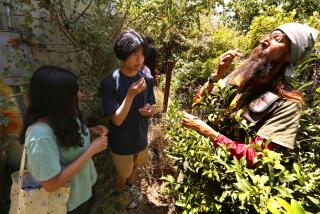SECOND OPINIONS : Pupils Seek Knowledge at Pressure-Free School : The children enrolled at a private elementary institution where there are no tests or textbooks teach each other and are truly interested in learning.
In the midst of all the news about what a disaster our local schools are--rated 48th or 50th among the states in everything except the dropout rate--what is one to think when hearing that there’s an elementary school in the San Fernando Valley that doesn’t even give its pupils grades, textbooks or tests?
A parent’s nightmare? To find out, I visited the place, Children’s Community School, a private elementary school in an industrial and commercial area near Victory and Van Nuys boulevards.
Inside a former church, cleverly converted by a modern architect into a warren of classrooms and workrooms, I found that the children often teach one another. They spend a lot of time playing with oversized building blocks. And there aren’t any doors on the kids’ lockers.
I also noticed that the children seemed to be investigating me . I had an uncanny sense that they were watching me in the same way I was watching them--as a potential interview subject.
Indeed, they seemed to be interested in everything going on that day. When all 100 had gathered for a sort of assembly, I saw some as young as 8 and 9 interrogating a panel of schoolmates from the grade above them, who had visited a space-science museum.
It looked like a pint-sized NASA press conference, with the usual mix of ethnic and gender-diverse astronauts being interviewed by an equally diverse flock of journalists. The questions and answers were so clearly framed and the line of the inquiry so lucid that I took the head of the school, Neal Wrightson, aside and remarked that the questions were better than some I’ve heard at real press conferences.
“But they want to know , unlike people at regular press conferences,” he said with a grin.
I began to realize how it might be that at CCS, as it’s called by its fans, the kids graduate as avid readers and go on to be top performers in high school having never taken a standard exam.
*
The teachers demand that the children do a lot of reading--the school has an extensive library--and write extensive journals, activities that consume a great deal of school and homework time. The child soon learns that the teacher and parents have agreed that homework is not a choice, it must be done.
“We give no standardized tests except to sixth-graders who need a score to send to their next school,” Wrightson said. The results? Last year, 100% of the school’s graduates were admitted to such academically demanding high schools as Oakwood, Harvard-Westlake, Buckley, Chaminade and Steven Weiss. Many won scholarships.
Contrary to functioning as a secret hatching pond for Valley yuppies, Children’s Community School runs on a fiercely egalitarian philosophy.
Its founder and retiring co-director, Leni Jackson, is a woman of startling energy and an advocate of the century-old education ideas of the philosopher John Dewey. She has been an educator for 50 years and there is absolutely no fat in her conversation.
Jackson started the school single-handedly 15 years ago as she entered her 60s, when most people are thinking of retirement. “The future of the world is in cooperative living and cooperative learning,” she says. “Our goal is to educate a citizen who has empathy for somebody else.”
So, for instance, the older children help out in the kindergarten classes, reading aloud and putting on plays.
Nearly half the kids have some kind of need-based scholarship. Those families who are paying the full $8,000 “know they are helping,” Jackson says.
Children at Children’s Community School spend lots of time working together. They build things out of giant blocks and discuss the results in sort of three-dimensional “reports” based on field trips to places such as bakeries, stores and factories. The business aspects of these places are emphasized and then play-acted, to hone math skills.
Once, Jackson said, after visiting the Page Museum at the La Brea Tar Pits, the kids had trouble using their blocks to replicate its layout, so they asked to go back.
When the kids are tested elsewhere, it seems that they are all over the bell curve. But they have learned how to learn, as their subsequent academic performance records show. It makes you wonder about the whole idea of tests. From what I saw, the school was turning the kids into competent people.
How good a school is it? I interviewed a number of parents of pupils and ex-pupils. The parents threw a celebration in the spring for Jackson’s 50th anniversary of teaching. Some came with their grown kids who were at the school 15 years ago and are now doing well in college. They all spoke of a period of adjustment. This school is hard work for the children and their parents.
“It may not be right for every parent, but it’s right for every student,” Wrightson quipped. “Family life is integral to children’s learning in school--it takes time and effort.” This gave me an inkling of why there are so few places like Children’s Community School around here.
I visited Children’s Community School several times, trying to figure it out. Two images haunt me: the children in the print shop hand-setting type for the student newspaper, reading backward of course, and also a journal one of them had written, to be bound between covers of heavy paper they had manufactured themselves. In the next room, an instrumental music class was rehearsing a piece by Carl Orff.
“By the time they leave CCS,” Jackson told me, “we want them to be bilingual, reading and writing music.” By that point, I must confess, my eyes had became perfectly round.
More to Read
Sign up for Essential California
The most important California stories and recommendations in your inbox every morning.
You may occasionally receive promotional content from the Los Angeles Times.










